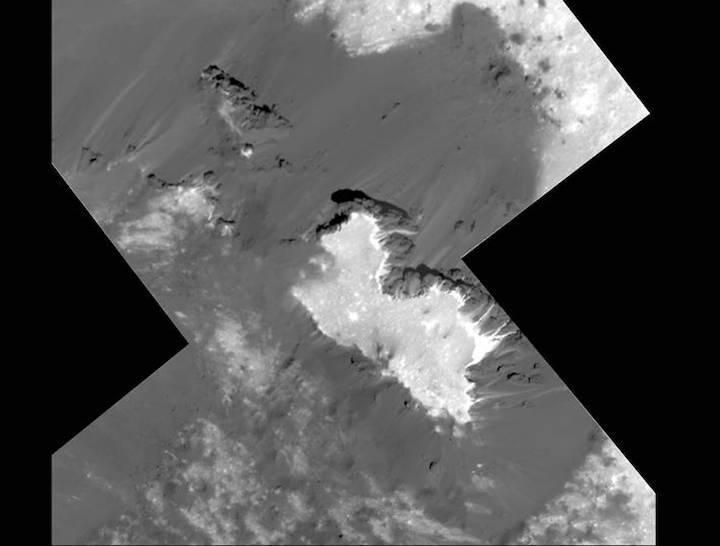15.03.2018
Dwarf planet Ceres has a water cycle but it’s not like Earth’s

IAPS - INAF
The dwarf planet Ceres, once thought to be a dead and static rock, may have water cycles. Observations from the Dawn spacecraft have shown a crater wall becoming icier as the sun’s position changed in the sky over the course of six months, indicating that subsurface ice particles may be lofted up into the air and land on the wall like dew.
On the steep wall of Juling crater in Ceres’s southern hemisphere, ice has been found to be increasing in the height of summer. During summer days on Ceres, sunlight hits the bottom of the crater but the wall remains mostly shrouded in cold shadows.
Carol Raymond at NASA’s Jet Propulsion Laboratory in Pasadena, California and her team examined infrared data from the Dawn spacecraft to figure out how the ice was changing in this crater as the warmest part of Ceres’s year began.
Decent exposure
In five sets of observations over the course of six months, they found that the amount of exposed ice on the Juling crater wall seemed to be increasing.
Raymond says this could be due to a combination of two effects: small landslides revealing ice from behind a layer of dust, and ice in areas that aren’t usually sunlit getting heated up enough to sublimate into the air.
“It’s only getting a few degrees warmer than during other seasons,” says Raymond. “But it’s enough to sublimate some of this ice that’s just below the surface.”
The final Dawn
The sublimated ice would work a bit like dew, which evaporates in the heat of the day and then condenses on cool surfaces in the night. In Juling crater, the pool of sunlight at the crater’s bottom has a similar effect, turning ice into water vapour. That vapour then condenses on the cool, shadowed wall that Raymond and her colleagues observed.
“It is surprising,” says Raymond. “This kind of process is seen on comets, but we didn’t really expect to see a cycle of sublimation and condensation in action on Ceres.”
The team is planning to look at Juling crater one more time before the Dawn spacecraft runs out of fuel, which is expected to happen sometime this year. Raymond hopes that understanding this process may help us understand why some areas of Ceres have more ice than others.
Quelle: New Scientist
+++
Dwarf planet Ceres may store underground brine that still gushes up today
Waterlogged minerals and changing ice add to evidence that Ceres is geologically active
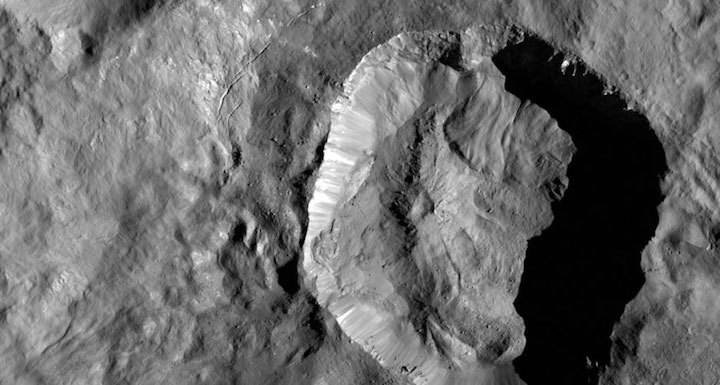
FOLLOW THE ICE A wall of ice in the shadows of Ceres’ Juling crater, shown here in an image taken by NASA’s Dawn spacecraft, grew by about 50 percent over the course of six months.
Ceres may be regularly coughing up briny water or slush onto its surface.
The discovery of waterlogged minerals and a growing ice wall suggests that the dwarf planet could harbor underground liquid water or slushy brine, which has escaped through cracks and craters in the recent past and may still be seeping out today. The findings, reported in two papers published online March 14 in Science Advances, add to a growing realization that Ceres is geologically active — and may point to new signs of the dwarf planet’s potential to host the ingredients for life.
“We thought of Ceres as a dead body like our moon,” says Andrea Raponi, a coauthor of both studies and a planetary scientist at the Institute for Space Astrophysics and Planetology in Rome. The growing body of evidence “means that Ceres is geologically alive, active, in our days.”
Since 2015, NASA’s Dawn spacecraft has orbited Ceres, the largest object in the asteroid belt between the orbits of Mars and Jupiter. The mission has previously revealed Ceres has water ice in shadowed regions of its craters and a few meters below the surface (SN: 1/21/17, p. 8). The dwarf planet also has what look like cryovolcanoes, which spew slushy water instead of magma.
Now, scientists have used data from Dawn to make the first global map of surface carbonate minerals, which form in the presence of liquid water. In one of the new papers, the team reports finding hydrated sodium carbonate — versions of the minerals that still have water molecules attached.
Small patches
Data taken by the Dawn spacecraft show that Ceres’ surface is covered in carbonate minerals that formed with water. Blue and magenta show widespread magnesium and calcium carbonates, while green and red show hydrated sodium carbonates. The hydrated carbonates are found in craters and on mounds, suggesting briny water or slush is reaching the surface in those zones.

Because the dwarf planet has no atmosphere, that water can’t hang around more than a few million years, says study coauthor Filippo Giacomo Carrozzo, also a planetary scientist at the Institute for Space Astrophysics and Planetology in Rome. With no protective shield, cosmic radiation breaks the water’s bonds to other molecules, and the water evaporates relatively quickly into space. The presence of so much hydrated sodium carbonate on the surface means something must be replenishing it.
Previous research had found other hydrated minerals called phyllosilicates on Ceres’ surface (SN: 10/1/16, p. 14). Finding more lingering water molecules further supports the idea that “the process of hydration is ongoing today,” Carrozzo says.
The hydrated sodium carbonates are particularly concentrated near craters and domes, suggesting that briny water or slush wells up from the subsurface in an ice volcano. Or impact craters may excavate rock and soil, exposing the brine, the researchers say.
Both ideas are “viable mechanisms,” says Lucy McFadden of NASA’s Goddard Space Flight Center in Greenbelt, Md., who is a member of the Dawn team but was not involved in the new papers. “It’s all pretty exciting stuff.”
In the second study, Raponi, Carrozzo and colleagues report that a wall of water ice in a crater called Juling grew from about 3.6 square kilometers to 5.5 square kilometers from April to October 2016. “We see, under our eyes, a change in the cover of water ice in a period of six months,” Raponi says. The change took place as the dwarf planet’s 4.6-year orbit was taking Ceres closer to the sun, the equivalent of moving from winter to spring, she says.
Some of the ice could have been buried beneath dirt, which sloughed off as the ice beneath it warmed and revealed fresh ice as the seasons changed, the team argues. Or freshwater or brine could have welled up from below and froze in the shadowed crater wall. Features on the crater floor seem to support this upwelling idea, Raponi says.
If water is upwelling from below, it’s hard to explain how it stays fluid beneath the surface, Raponi admits. Icy moons with subsurface oceans, like Enceladus and Europa, get a constant influx of heat from the gravity of the giant planets they orbit, Saturn and Jupiter. But Ceres has no such heat source.
But if Ceres does have a stable layer of subsurface liquid, that could increase its potential to be habitable, Raponi says. Previous studies have found organic molecules on Ceres’ surface, too (SN: 3/18/17, p. 8). “If we have all the ingredients of life in a geologically active body, that can be very interesting,” Raponi says.
Quelle: ScienceNews
---
Update: 3.06.2018
.
Dawn Mission: New Orbit, New Opportunities
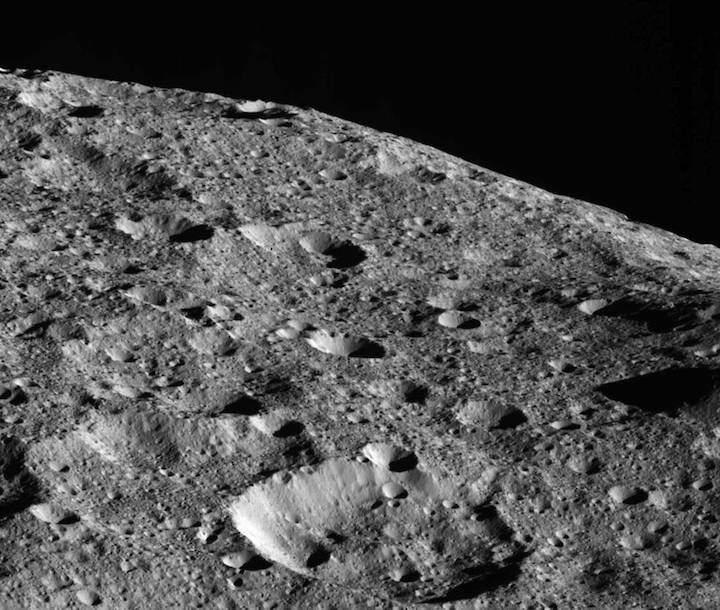
NASA’s Dawn spacecraft is maneuvering to its lowest-ever orbit for a close-up examination of the inner solar system’s only dwarf planet.
In early June, Dawn will reach its new, final orbit above Ceres. Soon after, it will begin collecting images and other science data from an unprecedented vantage point. This orbit will be less than 30 miles (50 kilometers) above the surface of Ceres -- 10 times closer than the spacecraft has ever been.
Dawn will collect gamma ray and neutron spectra, which help scientists understand variations in the chemical makeup of Ceres’ uppermost layer. That very low orbit also will garner some of Dawn’s closest images yet.
The transfer from Dawn’s previous orbit to its final one is not as simple as making a lane change. Dawn’s operations team worked for months to plot the course for this second extended mission of the veteran spacecraft, which is propelled by an ion engine. Engineers mapped out more than 45,000 possible trajectories before devising a plan that will allow the best science observations.
Dawn was launched in 2007 and has been exploring the two largest bodies in the main asteroid belt, Vesta and Ceres, to uncover new insights into our solar system. It entered Ceres’ orbit in March 2015.
“The team is eagerly awaiting the detailed composition and high-resolution imaging from the new, up-close examination,” said Dawn’s Principal Investigator Carol Raymond of NASA’s Jet Propulsion Laboratory, Pasadena, California. “These new high-resolution data allow us to test theories formulated from the previous data sets and discover new features of this fascinating dwarf planet.”
More detailed information about Dawn’s planned orbit is in Marc Rayman’s Dawn Journal. Rayman is Dawn’s mission director and chief engineer.
Quelle: NASA
---
Update: 16.06.2018
.
Dawn spacecraft flying low over Ceres

In the closing months of a nearly 11-year mission, NASA’s Dawn spacecraft has arrived in its final orbit around the dwarf planet Ceres and is obtaining the sharpest views yet of the king of the asteroid belt.
Dawn switched off its ion engine June 6 after reaching an elliptical orbit taking the spacecraft as close as 22 miles (35 kilometers) from Ceres on each 27-hour loop. At its highest point, the orbit takes Dawn to a distance of around 2,500 miles (4,000 kilometers).
The spacecraft is now flying 10 times closer to Ceres than ever before, allowing its science instruments to better resolve surface features and composition, with the new orbit designed to take Dawn low over Occator Crater, where bright salt deposits have garnered the attention of scientists and space enthusiasts.
Dawn is running low on hydrazine maneuvering propellant, and the spacecraft can no longer rely on spinning momentum wheels for pointing, but engineers stretched out the probe’s fuel lifetime to get an extra two years of science observations at Ceres.
NASA last year approved a final mission extension, and planners at the Jet Propulsion Laboratory crafted a new trajectory to take Dawn closer to Ceres. A series of ion engine burns, using electrically-charged xenon to continuously generate low levels of thrust for weeks at a time, guided Dawn into the lower orbit over the past few months.
Dawn paused in an intermediate orbit to take detailed images and infrared spectra of Ceres’ southern hemisphere in summer, when sunlight shines brighter. The improved illumination, and greater spectral coverage, will allow scientists to better compare the southern hemisphere with Ceres’ northern regions, which Dawn observed in summer earlier in the mission.
The Dawn spacecraft is the first to visit Ceres, which was previously studied exclusively through telescopes. Dawn arrived at Ceres in early 2015 after orbiting the giant asteroid Vesta in 2011 and 2012, making the robotic mission the first to orbit two objects in the solar system besides the Earth and the moon.
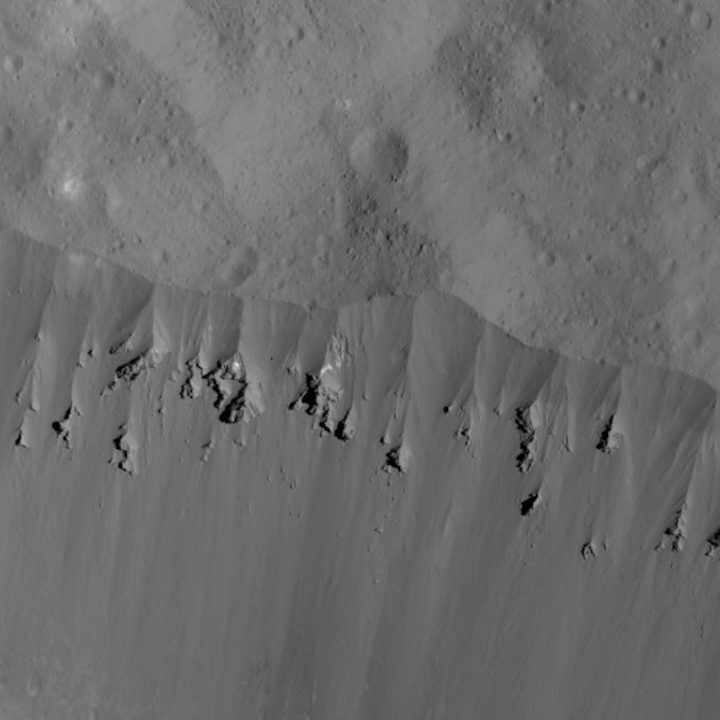
Ceres is the biggest object in the asteroid belt, a zone between the orbits of Mars and Jupiter. Measuring about 590 miles (950 kilometers) across, Ceres is about 40 percent the size of Pluto but comprises about one-quarter of the total mass of the objects in the asteroid belt.
The dwarf planet orbits the sun in a slightly elongated orbit, and it reached the closest point to the sun — called perihelion — in its 4.6-year-long year in April 2018 at a distance of around 238 million miles (383 million kilometers).
Dawn will consume more of its life-limiting hydrazine fuel in its new orbit. The spacecraft relies on its hydrazine-fueled thrusters to keep its instruments pointed at Ceres, and faster passages over the dwarf planet at low altitude require more propellant usage.
Three of the solar-powered craft’s four rotating reaction wheels, which pointed the probe using momentum, failed earlier int he mission, leaving Dawn’s rocket jets as the only means to control its orientation.
Dawn’s ultra-efficient xenon-fueled ion engines produce little thrust, and are used for large orbit adjustments, not for fine pointing.
After arriving in its new perch, Dawn resumed science observations June 9. The spacecraft has already beamed its first images from the low-altitude orbit back to Earth.
Dawn was built by Orbital ATK — now part of Northrop Grumman — and launched from Cape Canaveral in September 2007 aboard a Delta 2 rocket with nearly 100 pounds (45 kilograms) of hydrazine fuel in its 12-gallon (45-liter) tank.
Ground controllers do not know exactly how much propellant remains in Dawn’s tank because fuel measurement on-board spacecraft are imperfect. Engineers have tracked propellant usage by carefully cataloging every thruster firing and subtracting the estimated fuel burned from the quantity loaded into the spacecraft before launch.
Using the subtraction method, engineers have calculated that around 1.8 gallons (7 liters) of hydrazine are left in Dawn’s tank. But there is still some uncertainty in that estimate, and nearly a liter of Dawn’s hydrazine is classified unusable once pressures inside the craft’s propulsion system drop too low to push the fuel the probe’s 12 small rocket thrusters.
Taking into account all the uncertainties, engineers say Dawn likely has enough hydrazine to keep the spacecraft going for three months in its new orbit, meaning the mission will most likely end in September. But it could be August or October, according to Marc Rayman, Dawn’s mission director and chief engineer at JPL.
“The team will continue to guide Dawn in squeezing as much out of its time at Ceres as possible, acquiring new data until the spacecraft is unable to comply because it has expended the last puff of hydrazine,” Rayman wrote in a May 31 blog post on JPL’s website.
Once Dawn is out of fuel, its power-generating solar panels no longer point toward the sun, and its high-gain antenna will lose its lock on Earth.
“When the last of the hydrazine is used up, the spacecraft will actuate valves and try to fire thrusters to control its orientation, but hydrazine will no longer flow, so the torque it wants to exert will not be achieved,” Rayman wrote. “The spacecraft will be impotent, its attempts to point correctly futile. The struggle will be brief, as it will soon run out of electrical power, and the central computer will cease operating.”
Quelle: SN
---
Update: 1.07.2018
.
NASA Reveals Stunning New Photos Of Dwarf Planet Ceres
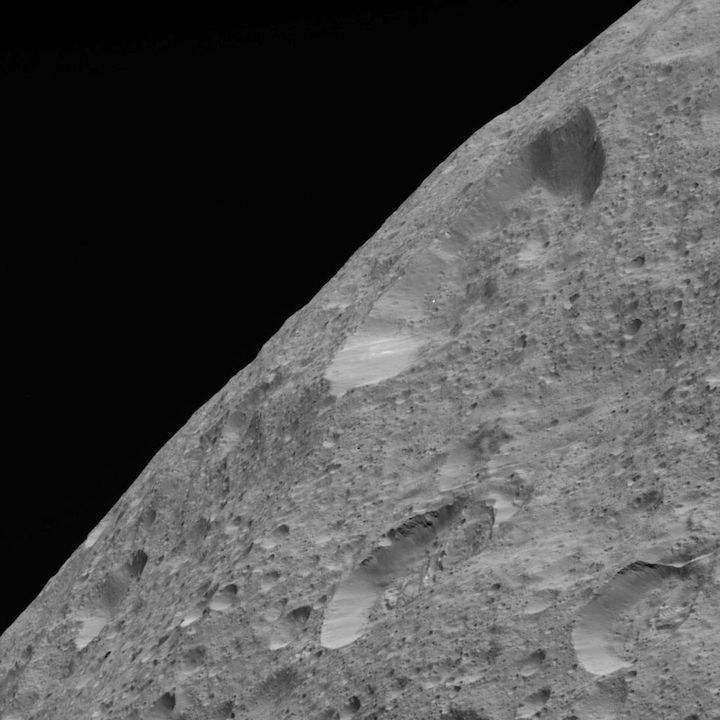
“These pictures are new to you and new to us too,” says Marc Rayman of the Jet Propulsion Laboratory in Pasadena, California. “It’s a wonderful flood of data.”
Every 27 hours, NASA’s Dawn spacecraft swoops near the surface of Ceres to grab the close-ups. At its lowest point, the probe is only 22 miles up. In outer space, that’s virtually skimming the ground.
The photo shoot started June 9; so far, Dawn has taken “hundreds” of pictures, says Rayman, “exotic alien landscapes, scenes truly otherworldly.”
The images are so new, NASA researchers “haven’t had time to analyze them yet,” he says.
“But it’s almost like we’re seeing a different Ceres.”
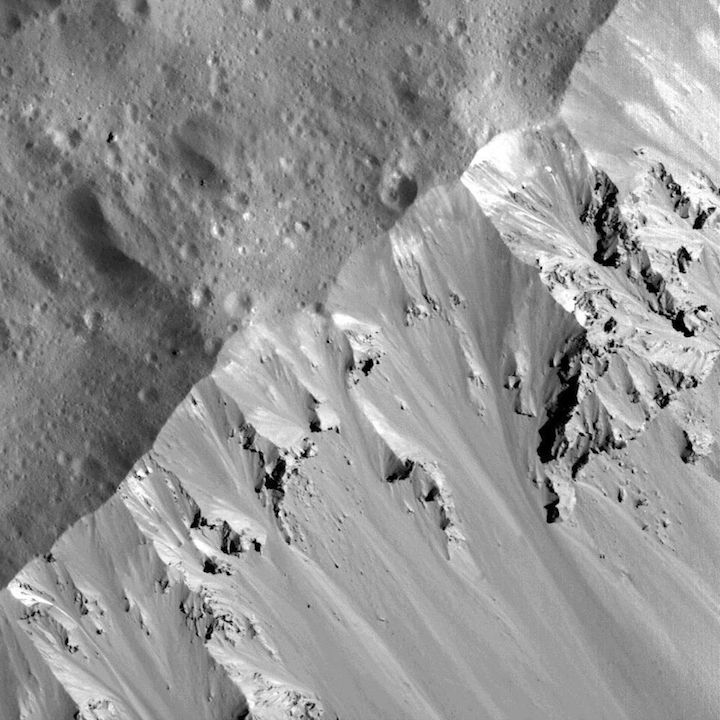
Space scientists already knew Ceres was more than a drab dead rock.
Dawn began orbiting the dwarf planet in March 2015; even before taking the close-ups, the spacecraft shot more than 50,000 images, all from hundreds or thousands of miles away.
Researchers mapped the surface. They analyzed data from the rest of Dawn’s instruments. They saw a cryovolcano, salt flats, and ancient Occator Crater, 57 miles across. They figured out that vast amounts of salt water, nearly all frozen, dwells underground.
They also found organic materials—the “building blocks” for life.
Indeed, the latest data shows lots of organics: “One area of 3,700 acres, covered with it,” says Rayman. “Five to ten times more prevalent than we thought was there.”

Ice in the northern wall of Juling Crater. Dawn is 240 miles above Ceres.
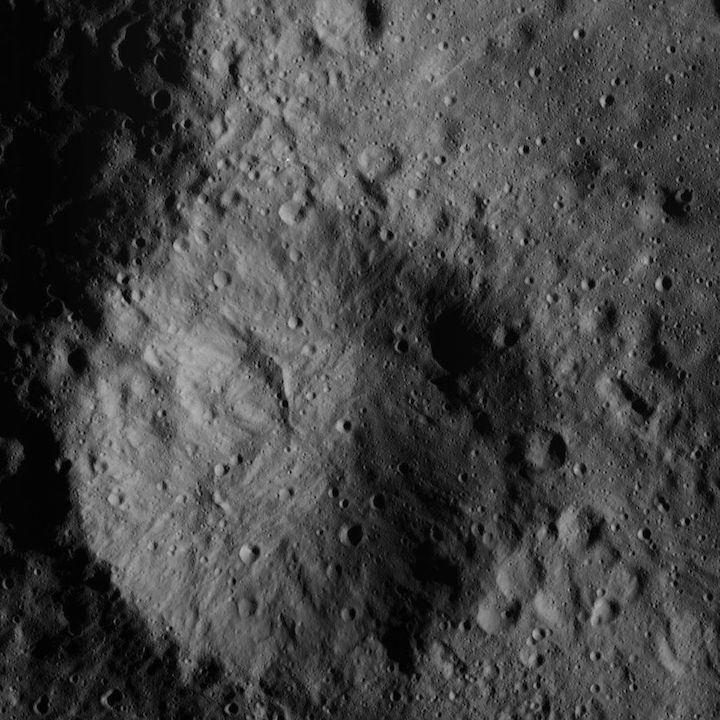
Still, Rayman—the chief engineer and mission director of the project—is skeptical that Ceres has life.
“It (life) is an extreme remote possibility,” he says.
“Ceres does have many of the ingredients we think are necessary for life—water, organics, a source of energy, internal geological forces.
“But you need to combine the ingredients in the right way.”
Ceres likely does not. Daytime surface temperature is minus 100 degrees Fahrenheit. Any atmosphere is barely there, transient at best.
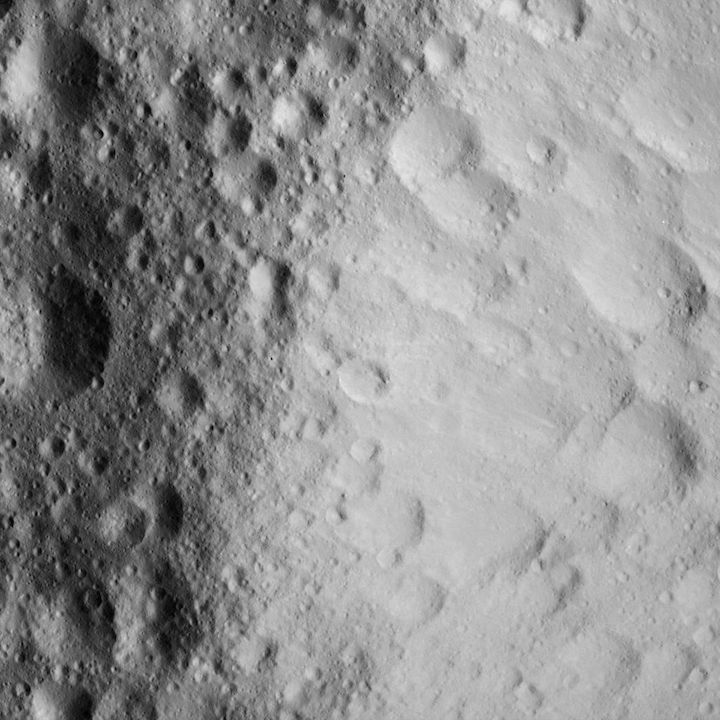
A battered crater rim on Ceres. Image taken by Dawn from 25 miles up on June 10, 2018.

The close-ups are the spacecraft’s last hurrah; Dawn is nearly out of fuel. Less than two gallons of hydrazine are left.
“In this low-altitude orbit, we use the propellant much more quickly,” says Rayman. “So it’s going fast.”
The hydrazine may last another few weeks, or a few months, but is surely gone sometime between August and October.
When that happens, Dawn is dead. “It won’t be able to control its orientation, point its antenna to Earth, point its camera, or point the ion engine,” Rayman says.
Instead, Dawn will engage in an endless dance around Ceres, forever in orbit.
Rayman, with the mission nearly 16 years, has “bittersweet” feelings.
“Dawn was powered by the burning desire to know the cosmos,” he says. “It’s not just the ion propulsion that got us there.”
Yet research never stops. Generations of scientists will download the data from Dawn for decades to come.
Says Rayman: “The spacecraft won’t continue. But its legacy will.”
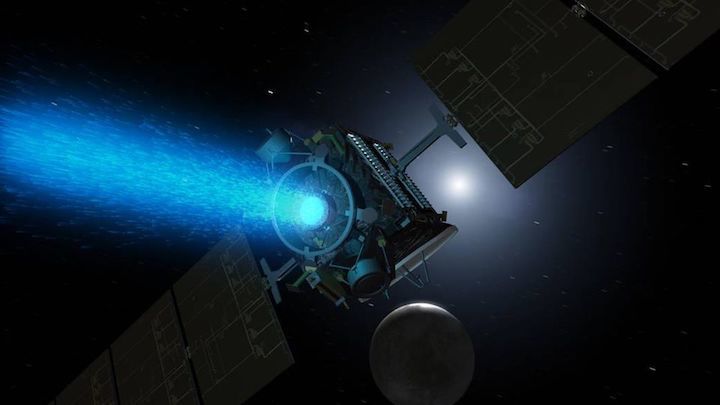
Quelle: Forbes
---
Update: 2.07.2018
.
Dawn's Engines Complete Firing, Science Continues

Mission controllers have turned off the industrious ion engines on NASA's Dawn spacecraft for the last time and do not expect to turn them back on again, if everything goes as planned for the rest of Dawn's mission in orbit around Ceres, the largest body in the main asteroid belt. Engineers led by Dawn Project Manager Marc Rayman of NASA's Jet Propulsion Laboratory, Pasadena, California, drew this conclusion on Tuesday, June 26, after analyzing data from Dawn's last thrusting session on Thursday, June 21, and verifying plans for the rest of the mission. Mission managers expect Dawn to continue gathering science data and transmitting it to Earth for another few months.
Dawn turned on its innovative ion engines for the first time on Oct. 6, 2007. That technology has allowed Dawn to become the first mission to orbit two solar system destinations outside of the Earth-Moon system -- first Vesta and then Ceres - and to do groundbreaking science at these two bodies. During more than a decade in space, Dawn's ion engines have set records for total firing time of 5.87 years and total effective velocity change by a spacecraft of 25,700 mph (41,360 kph).Because of the nature of orbital motion, that is not Dawn's actual velocity. Spacecraft slow down relative to the Sun as they go outward in the solar system, Rayman explained. Read more about orbital velocity here.
"Dawn's remarkable ion engines have taken us on an exciting extraterrestrial expedition that would have been impossible without them," said Rayman. "The engines are healthy and ready in case we ever need them again, but they have taken Dawn exactly where we want it to be. We will remember the engines and their cool blue glow with fondness and gratitude."
Quelle: NASA
---
Update: 4.07.2018
.
Quelle: NASA

